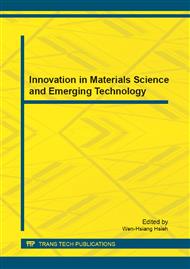p.88
p.93
p.99
p.104
p.109
p.114
p.119
p.124
p.129
Enhancement of Coupling Efficiency of Butterfly Package Laser Modules Based on Post-Weld-Shift Compensation
Abstract:
When fabricating laser diode transceiver modules, the coupling efficiency can be improved via a laser hammering process, in which additional, calculated spot welds are performed at key locations within the package in order to compensate for post-weld shift. The present study performs a numerical investigation into the post-weld-shift compensation of a butterfly laser module package incorporating a lensed optical fiber and a laser diode with a central wavelength of 980 nm. In performing the simulations, the deformation of the package components during the welding process is modeled using Marc finite element software. Furthermore, the laser power coupling efficiency is estimated using the commercial Zemax optical design program. It is shown that the numerical predictions for the coupling power in the laser diode transceiver module are in good agreement with the experimental results. The optimal welding sequence which minimizes the post-weld shift of the optical fiber relative to the laser diode is determined. It is shown that the corresponding coupling efficiency is equal to 69%. Finally, it is shown that by performing an optimized laser hammering process, the coupling efficiency can be improved to around 99%.
Info:
Periodical:
Pages:
109-113
Citation:
Online since:
December 2011
Authors:
Price:
Сopyright:
© 2012 Trans Tech Publications Ltd. All Rights Reserved
Share:
Citation:


